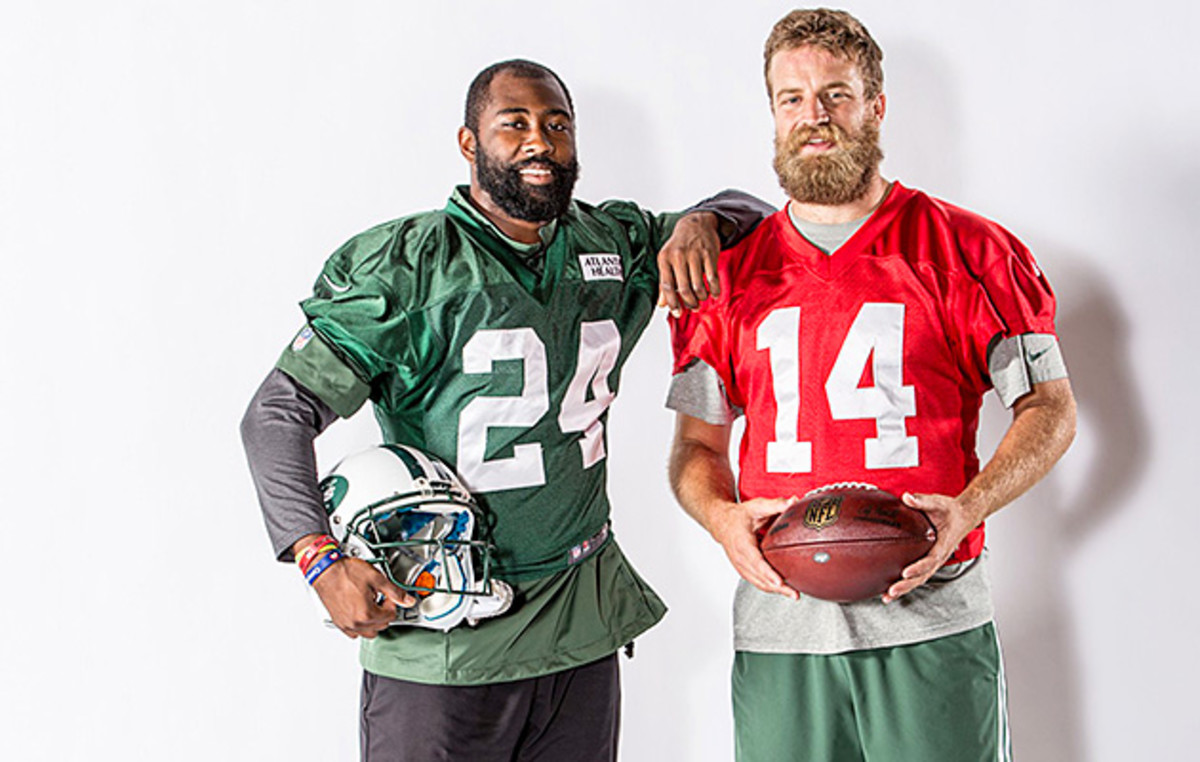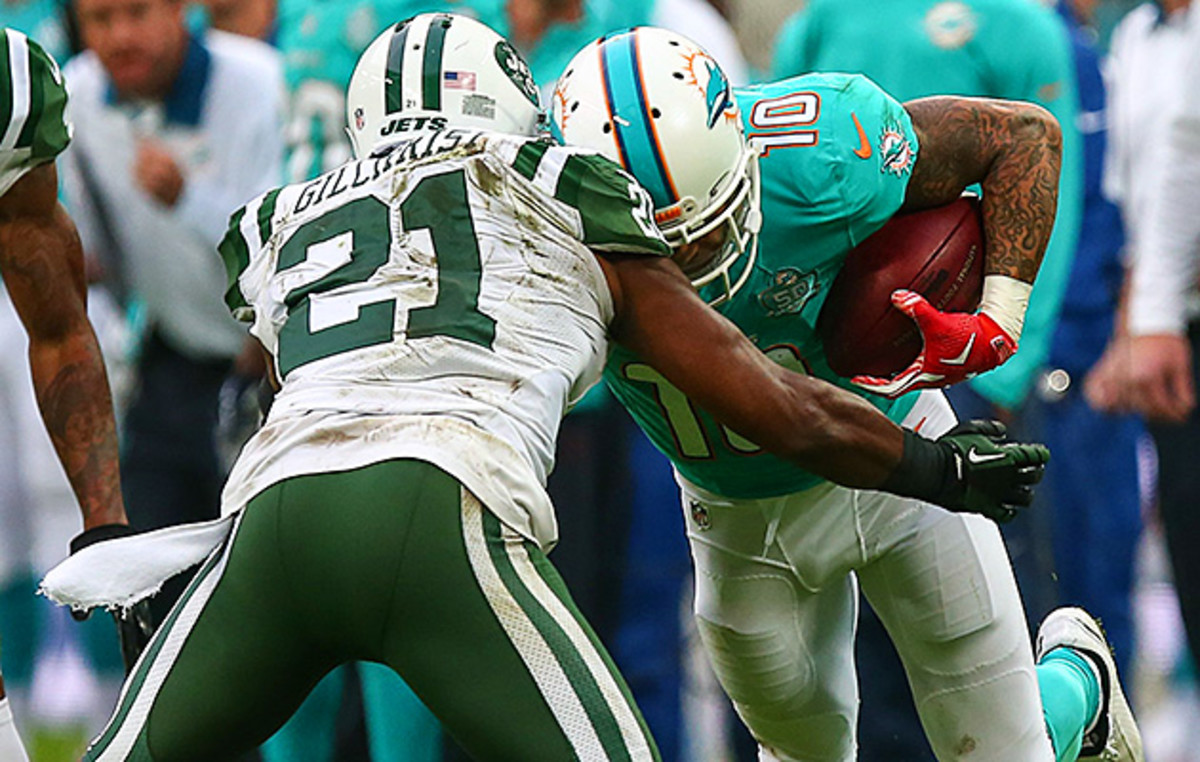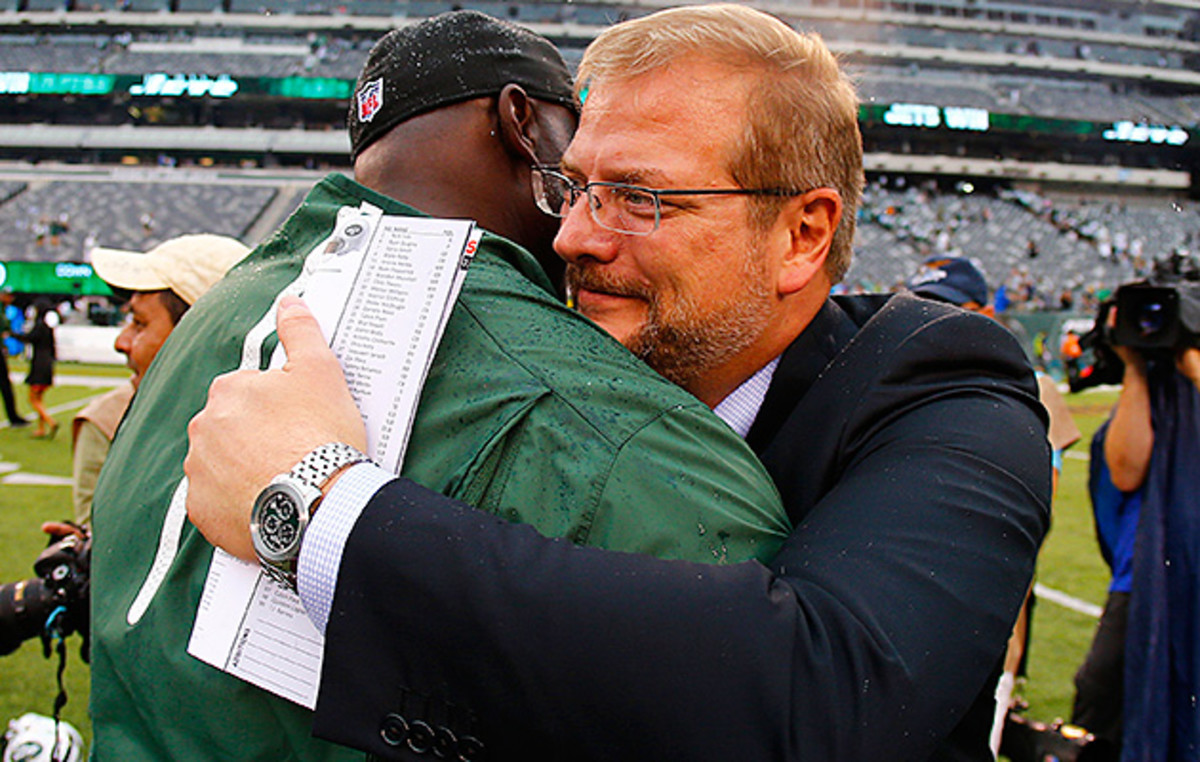Nine days, seven players, $200M: How new GM sparked new-look Jets

This story appears in the Oct. 19, 2015, issue of Sports Illustrated. Subscribe to the magazine here.
The general manager who engineered the NFL's best off-season is a history buff, a grunge band aficionado and a Game of Thrones devotee. He can consume 12 to 15 cups of coffee a day but is trying to cut back to something reasonable. Like nine cups.
Mike Maccagnan reveres Abraham Lincoln, references the Napoleonic Code and devours books, like On War, about military strategy. He's forever the son of a history teacher, which is fitting because the franchise he took over back in January has a past best described as “tortured.” At the risk of sounding redundant: Maccagnan is the GM of the Jets.
Before he climbed to director of college scouting for the Texans, before the front-office gigs in Saskatchewan and Ottawa and London, before he shelved the dream of becoming a financial analyst on Wall Street, Maccagnan was an intern for the Redskins in 1990. He often shuttled players to and from the airport. It's possible—likely, even—that at some point he ferried a veteran Washington safety named Todd Bowles.
•MMQB: From apprentice to master, Bowles is remaking the Jets
Both men grew up in New Jersey—Maccagnan outside Princeton, Bowles in Elizabeth. And both shared an obsession: football. Bowles was the star player with a scholarship to Temple; Maccagnan was the future economics major besotted with the NFL draft. (He also played some nosetackle at Trinity College, in Connecticut.)
Week 7 picks: Jets visit unbeaten Patriots with AFC East on the line
Maccagnan's boss with the Skins, GM Charley Casserly, sensed that his Nirvana-jamming intern could see the bigger picture—how to construct a team from so many disparate personalities and skill sets—and he tabbed Maccagnan as a future personnel executive. Meanwhile, Washington quarterback Doug Williams saw in his friend Bowles a mild-mannered safety who never seemed out of position and who went everywhere whistling Gladys Knight tunes. Bowles aligned the secondary that intercepted three John Elway passes in the Redskins' 42-10 triumph over the Broncos in Super Bowl XXII. He struck Williams as a future coach.
Flash forward to January 2015. The Jets, with Casserly on their search committee after flaming out at 4-12 and firing Rex Ryan, name Maccagnan their new GM. Maccagnan drives to the airport to pick up a candidate for the vacant head coach position: Bowles, the Cardinals' defensive coordinator known for his blitz-heavy schemes. The two men pass Elizabeth en route to the team's facility in Florham Park, but they do not reminisce. There's no time for two Jersey guys to consider any history other than that which they hope to make together.
Maccagnan hires Bowles, and they gather, along with New York's personnel department, inside a conference room on most days between January and March to evaluate free agents. They know they have more than $50 million available in cap space and that they need to overhaul their secondary and that they want a receiver, a guard and a veteran backup quarterback. Tape plays from 7 a.m. most mornings until 7 p.m. some nights. They make a wish list and organize nameplates on a whiteboard. It feels like something straight off of Maccagnan's bookshelf—big picture, all strategy and tactics.
Soon, the nine days in March that will redefine a franchise will be upon them.

The story of those nine days is the story of the modern NFL, where the salary cap has swelled to $143.28 million and player movement has reached unprecedented levels. Ideally, all franchises want to build through the draft, a cheaper, more sustainable alternative to free agency. But Maccagnan and Bowles did not enter into an ideal world. They inherited a team with more holes than draft picks.
The Jets knew their roster remodeling would not come cheap. Everyone overpays in free agency. The key is not to overpay too much, to minimize risk and maximize return.
• MMQB: Wilkerson on his kinship with Bowles, desire to sack Brady
On March 5, while attending Clemson's pro day, Maccagnan ran into newly hired Bears GM Ryan Pace. Chicago needed to move either quarterback Jay Cutler or receiver Brandon Marshall, two former friends who'd become embroiled in a public feud. Maccagnan imagined Marshall's bolstering the Jets' passing offense, which had ranked dead last in 2014, with just eight TDs by wide receivers. Denver, Miami, Chicago—Marshall found the end zone wherever he played.
Jets’ low-risk off-season moves pay off as Marshall, Fitzpatrick shine
While the teams exchanged proposals, the Jets dug into Marshall's background, which included a history of domestic violence allegations (no criminal charges have ever been filed), skirmishes with teammates and a diagnosis of borderline personality disorder. Marshall had been playing for the Dolphins in 2011 when Bowles, then an assistant, became Miami's interim coach late in the season. Bowles liked that the receiver arrived before teammates most mornings and never dropped his intensity. So he vouched for him. The Jets dealt a fifth-round pick for Marshall and his 65 touchdown receptions (plus the Bears' seventh-round selection) on March 10. Extreme Makeover, Florham Park Edition had begun.
Ryan Fitzpatrick saw the Marshall trade scroll across the ticker at home in Houston, where his wife was expecting their fifth child and the quarterback was rehabbing a broken left leg. “I was trying to get over the fact that I was probably headed to my fourth team in four years,” says the now-former Ram, Bengal, Bill, Titan and Texan. “That's been our life, the craziness. We had so many houses, I was slowly becoming a real estate mogul.”
Roger Goodell is good at parts of his job, and Yahoo! game proves that
The Jets wanted Fitzpatrick because the QB had spent three seasons in Buffalo playing for New York's new offensive coordinator, Chan Gailey. He could translate the playbook. He could also compete with incumbent Geno Smith and mentor any quarterback the Jets might draft. (They figured at that point to take at least one.) The counseling part of the job was particularly important because the consensus was that the previous year's backup, Michael Vick, had no effect on Smith. He wasn't a bad influence, but he wasn't a mentor, either.
Fitzpatrick's agent called and told him not to report to the Texans' facility for rehab. Something was in the works—another trade. New York obtained Fitzpatrick for a conditional seventh-rounder.
Two days, two deals.
Meanwhile, free agency had started.
After Skrine signed, he says “the dominoes started to fall. Like a snowball rolling down the hill.”
At the NFL scouting combine in February, Maccagnan had stood before a throng of media and promised that the Jets would be active in free agency. He had a plan. Watching in 2011 he had learned a valuable lesson: While several teams waited for the top cornerback, Nnamdi Asomugha, to decide where he was going, the Texans snuck in and landed Johnathan Joseph, the consensus No. 2 corner. By the time the losers in the Asomugha sweepstakes shifted their dollars elsewhere, they were stuck with No. 3, at best. In '15, while dozens of franchises focused their attention on one of two corners, Darrelle Revis and Byron Maxwell, Maccagnan simultaneously tilted his aim a hair lower, targeting the Browns' Buster Skrine.
Blanket Coverage: Improved defense buoying Steelers without Big Ben
The Jets fancied Skrine as a potential nickel corner, a hybrid player in Bowles's ever-shifting defense. In the end, six teams pursued Skrine, but he committed to New York over the phone, without a visit. Why? He wanted to play for Bowles. “His system was similar to what I had played in Cleveland—only a little bit better,” says Skrine. Then, he explains, “the dominoes started to fall. Like a snowball rolling down the hill.”
When the Patriots (predictably) declined to pick up Revis's $20 million option for a second year in New England and he hit the open market, the Jets—familiar with his skill set and comfortable with the price—pounced. Their offer contained $39 million in guaranteed money over the first three seasons of a five-year deal. Revis and his representatives gathered at a condominium in Hollywood, Fla., with sweeping views of the Atlantic Ocean and agreed to terms barely four hours after Skrine had signed. They celebrated with seafood, pasta and wine. “I was looking at the roster, all the pieces,” says Revis, who played for the Jets from 2007 through '12. “You could see where they were headed.”
With two corners committed, the Jets chased after a guard. They failed to land Mike Iupati (who ended up with the Cardinals) and Orlando Franklin (Chargers) but managed to procure their third choice, James Carpenter, a four-year starter with the Seahawks. The Skrine, Revis and Carpenter contracts became official on March 14. The Carpenter deal yielded a bonus: Because he came cheaper than the other guards the Jets had eyeballed, they had about $4 million in additional leftover cash.
Revis, for one, knew where to spend it. He sent a text message to cornerback Antonio Cromartie, a former teammate who'd spent 2014 playing for Bowles's Cardinals. “What's up, man?” Revis tapped into his iPhone.
“I'm coming,” Cromartie wrote back.
As the flurry of activity continued, free-agent defensive back Marcus Gilchrist toured the Jets' palatial headquarters, the walls lined with murals of fans, the cafeteria stocked with organic food. He wondered if there was any money left.
There was, but it came with one condition: New York wanted to shift Gilchrist—until then a cornerback and strong safety—to free safety, a position he'd played some in San Diego. If that happened, they could move Calvin Pryor from free safety to strong, a position that better matched his skill set: stop the run, hit, hit, hit.
Gilchrist reminded Bowles of Tyrann Mathieu, another corner turned safety who played a hybrid role in his Arizona defense. In New York, Bowles would give Gilchrist similar responsibilities: make the defensive calls, align teammates, shift coverages. Seven months later Bowles calls Gilchrist the Jets' most underrated acquisition. “He's our Tony Parker,” says Revis.

The Gilchrist and Cromartie signings became official on March 18, eight days after the Marshall trade. In dizzying total the Jets had obtained six starters and a nickel cornerback—basically another starter. Their billionaire owner, Woody Johnson, had committed almost $200 million to those players and guaranteed $87.3 million. Still, Maccagnan included outs in several of the deals, allowing for flexibility in future off-seasons.
New York's rebuilt 53-man roster featured 20 new players when the season started, a turnover of about 38%. “We expected change,” says left tackle D'Brickashaw Ferguson. “But this was extreme, unlike anything I've been through. It really is a whole new locker room.”
In those nine days, Maccagnan had consumed something shy of 135 cups of coffee and lost about 10 pounds. To celebrate his haul, he started to sign lower-level free agents. “I need to buy him a Starbucks,” says Bowles.
He doesn't mean a single latte. He means a store.

All that movement caught the eye of Bowles's mentor, Bill Parcells, who had hired Bowles as a defensive backs coach with the Jets(in 2000) and the Cowboys ('05). “I always thought he had the qualities to be a head coach,” says Parcells. “He's steady. And he's smart.”
Parcells sees roster construction as a process without an endpoint, and he notes that beyond the players the Jets acquired in free agency, they also gained flexibility for the draft. They figured that the top QB prospects (Florida State's Jameis Winston and Oregon's Marcus Mariota) would be gone by the time they picked at No. 6, and they graded three players (USC defensive end Leonard Williams, Alabama receiver Amari Cooper and Florida D-end Dante Fowler Jr.) in a tier above the remainder of the field. Do the math: Five players, sixth pick ....
As the draft approached, New York inquired about moving up to take one of the two quarterbacks but found the cost prohibitive. Jacksonville, at No. 3, feigned interest in Cooper, but that proved to be a smokescreen. The Jags took Fowler, and the Raiders nabbed Cooper next.
When the Redskins drafted Iowa tackle Brandon Scherff at No. 5, the Jets' draft room erupted in cheers. Williams, a player many experts tabbed as the draft's best talent, had fallen to them. That New York's defensive line was its strongest unit mattered not even a little bit. The Jets called up Williams. He could hear the celebration in the background.
He became the eighth starter they added this off-season.
On Oct. 12, Bowles stood before his team, following New York's bye week. He told his players they have not arrived. “You haven't done anything yet,” Bowles told them.
New York's season started in typical fashion, which is to say chaotically. The team's MVP from 2014, defensive tackle Sheldon Richardson, was arrested in July for resisting arrest and for multiple traffic violations (he pleaded not guilty and is awaiting trial)—that on top of his existing four-game suspension for violating the league's substance abuse policy. Linebacker IK Enemkpali coldcocked Smith over a $600 debt in August, breaking the QB's jaw. “Busy” is all Bowles will allow to describe that time period.
That isn't the unexpected part. The surprise—outside of the locker room, at least—has been the Jets' winning four of their first five games, largely on the contributions of the eight impact players (counting Williams) they obtained this off-season. New York's revamped, and vastly improved, secondary has allowed Bowles to blitz more than any other team, leading to 15 takeaways, second in the NFL. (The Jets got 13 in all of 2014.) Fitzpatrick has maintained the NFL's bushiest beard and usurped Smith as the starting quarterback. He's connected with Marshall, a voracious reader of self-help books, for 511 yards and four touchdowns. And Carpenter has solidified a veteran offensive line that opens holes for Chris Ivory, who averages 5.5 yards per carry, tied for first among backs with at least 60 totes.
Against The Grain: Every undefeated NFL team will lose by Week 9
The Jets toppled the Redskins on Sunday, 34-20, their fourth win by double digits, and set up a marquee Week 7 matchup against the undefeated Patriots. Later—30 minutes after Revis baited Washington quarterback Kirk Cousins into an interception that sparked a 24-point swing, after Marshall hauled in seven passes for 111 yards and a score, after Fitzpatrick torched the Skins for 253 yards and three TDs and Ivory rumbled for 146 yards and another score—Revis was reenacting his pick in the locker room. He was singing Drake: “Jumpman, jumpman, jumpman....” A few lockers over, Marshall, the first Jets receiver since Don Maynard in 1968 with four straight 100-yard games, sat alone. “Oh, man,” he said, to no one in particular. Fitzpatrick walked by and slapped him on the back. They exchanged no words. They didn't have to. Their record says enough.
Issues remain, though. Like: Fitzpatrick's whopping seven interceptions, the 14 penalties against the Dolphins in Week 4, punt-coverage struggles. But those are minor quibbles. The Jets—the Jets!—rank among the NFL's most surprising teams, and they arrived here via the route, free agency, that fails more often than not. “That comes down to availability [versus] need, and money,” says Casserly. “And Mike had all three.”
Inside his office last week, with papers scattered atop his desk, Bowles tried to minimize the Jets' surprise start. He wore a black hat, a gray sweatshirt and an expression that landed somewhere around bemused. He had added all those players and survived two crises, and yet he sounded unimpressed. On Oct. 12, he had stood before his team, following New York's bye week. He told his players they have not arrived. They haven't yet won a close game in the fourth quarter, haven't secured a victory through special teams, haven't beaten a team like the one they will face this weekend, their bitter rival, the defending champion Patriots. “You haven't done anything yet,” Bowles told them.
That's the thing, though, about the way the Jets reconfigured: It appears they had New England in mind. A corner like Skrine can shadow shifty slot receivers like Julian Edelman or Danny Amendola. A versatile safety like Gilchrist helps eliminate the need to substitute against a Patriots offense that often goes no-huddle, with various combinations of pass targets. A receiver like Marshall can manhandle defenders in the red zone. A stacked defensive front like New York's can pressure Brady up the middle, which is the only pressure that consistently seems to frustrate him.
The Playbook: A complete guide to Week 7 action around the NFL
Altogether, it's enough to give even the most cynical Gang Green fans hope, even those accustomed to fake spikes and butt fumbles and late-season collapses. The Jets, once 100-to-1 long shots to win the Super Bowl, are now 25-to-1, according to some sports books. And those odds look to improve. Richardson has returned from suspension. Running back Stevan Ridley (ACL/MCL) could return later this month. So could cornerback Dee Milliner (wrist), a first-round pick in 2013. The schedule—with games remaining against the Raiders, Jaguars, Bills, Texans, Dolphins, Giants and Titans—looks softer than Fitzpatrick's beard after a nice conditioning.
In a way, it feels like 2008 all over again, when GM Mike Tannenbaum wheeled and dealed, adding Brett Favre, Alan Faneca, Kris Jenkins, Calvin Pace, Damien Woody and Tony Richardson through a combination of free-agency maneuvers and trades. Those players—minus Favre, who left after one year—formed the spine of a team that went to back-to-back AFC title games.
But Jets fans would prefer that this team recall another one, the 1968 outfit that won New York's first and only Super Bowl. Maccagnan could celebrate a title with his favorite beverage, a cup of coffee. Or 15.
